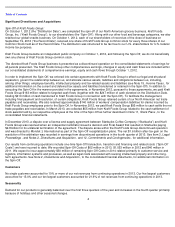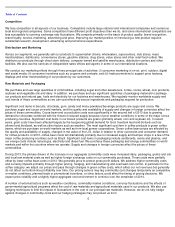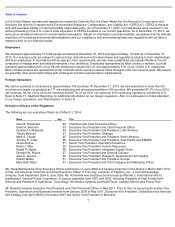Mondelez 2013 Annual Report Download - page 15
Download and view the complete annual report
Please find page 15 of the 2013 Mondelez annual report below. You can navigate through the pages in the report by either clicking on the pages listed below, or by using the keyword search tool below to find specific information within the annual report.
Table of Contents
In addition, political and economic changes or volatility, geopolitical regional conflicts, terrorist activity, political unrest, civil strife,
acts of war, public corruption, expropriation and other economic or political uncertainties could interrupt and negatively affect our
business operations or customer demand. We could also be adversely impacted by continued instability in the banking and
governmental sectors of certain countries in the European Union or the dynamics associated with the federal and state debt and
budget challenges in the United States. All of these factors could result in increased costs or decreased revenues, and could
materially and adversely affect our product sales, financial condition and results of operations.
Our operations in certain emerging markets expose us to political, economic and regulatory risks.
Our growth strategy depends in part on our ability to expand our operations in emerging markets, including Brazil, China, India,
Mexico, Russia, Venezuela, Argentina, Ukraine, the Middle East and Africa, and Southeast Asia. However, some emerging markets
have greater political, economic and currency volatility and greater vulnerability to infrastructure and labor disruptions than more
established markets. In many countries outside of the United States, particularly those with emerging economies, it may be
common for others to engage in business practices prohibited by laws and regulations with extraterritorial reach, such as the FCPA
and the U.K. Bribery Act, or local anti-bribery laws. These laws generally prohibit companies and their employees, contractors or
agents from making improper payments to government officials, including in connection with obtaining permits or engaging in other
actions necessary to do business. Failure to comply with these laws could subject us to civil and criminal penalties that could
materially and adversely affect our reputation, financial condition and results of operations.
In addition, competition in emerging markets is increasing as our competitors grow their global operations and low cost local
manufacturers expand and improve their production capacities. Our success in emerging markets is critical to our growth strategy.
If we cannot successfully increase our business in emerging markets and manage associated political, economic and currency
volatility, our product sales, financial condition and results of operations could be materially and adversely affected.
The consolidation of retail customers creates larger retailers with increased influence in the marketplace.
Retail customers, such as supermarkets, warehouse clubs and food distributors in the European Union, the United States and our
other major markets, continue to consolidate, resulting in fewer customers on which we can rely for business. Consolidation also
produces larger, more sophisticated retail customers that can resist price increases and demand lower pricing, increased
promotional programs or specifically tailored products. In addition, larger retailers have the scale to develop supply chains that
permit them to operate with reduced inventories or to develop and market their own retailer brands. Further retail consolidation and
increasing retail power could materially and adversely affect our product sales, financial condition and results of operations.
Retail consolidation also increases the risk that adverse changes in our customers’ business operations or financial performance
will have a corresponding material adverse effect on us. For example, if our customers cannot access sufficient funds or financing,
then they may delay, decrease or cancel purchases of our products, or delay or fail to pay us for previous purchases, which could
materially and adversely affect our product sales, financial condition and results of operations.
Changes in our relationships with significant customers or suppliers could adversely affect sales and our ability to supply
products to our customers.
During 2013, our five largest customers accounted for 15.0% of our net revenues. There can be no assurance that our customers
will continue to purchase our products in the same mix or quantities or on the same terms as in the past, particularly as increasingly
powerful retailers continue to demand lower pricing and develop their own brands. The loss of a significant customer or a material
reduction in sales, or a change in the mix of products we sell to a significant customer, could materially and adversely affect our
product sales, financial condition and results of operations.
11
• greater risk of uncollectible accounts and longer collection cycles,
• design and implementation of effective control environment processes across our diverse operations and employee
base, and
• imposition of more or new tariffs, quotas, trade barriers, and similar restrictions on our sales or regulations, taxes or
policies that might negatively affect our sales.
























